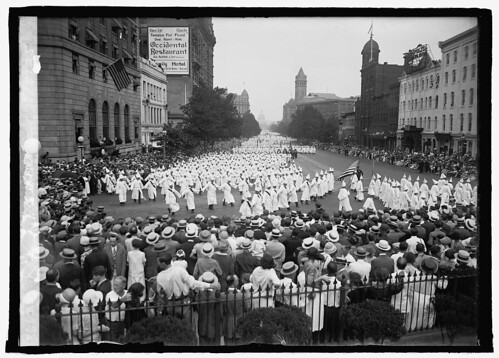As we come to the end
of the Virtual Series, we at last come to what many consider our most striking
but controversial image. A bit of
context: The process that went into choosing each picture for the façade was
one of telling a story. There were more than a dozen pictures to choose from,
and each one selected told a piece of the South’s rich history and its spirit
of reinvention. We looked at the early trolley systems, mill strikes, booming
businesses, growing diverse cultures, significant figures, and much more to
reveal the progress and pain that went into creating the New South. Some images were more provocative than others,
but their stories were important to tell.

For this week, as we conclude our Summer Virtual Series, we want to take
a moment to address our community. This
week’s image, although it has been a part of the building with the rest of the
pictures, has been a continuing item of concern within the community. It is one
that causes many people to ask “Why would
you put something like that on the building?” The short answer is that the
museum is dedicated to telling the history of the South-- the good and the bad. 
The image of a little girl at a Ku Klux Klan rally has been
a point of apprehension or contention for many people who come to the museum or
who are just passing by. As we continue to tell the stories that these images
hold, we also want to show the community that we were listening to your
thoughts about this particular image. We know the image of the Klan evokes strong
emotions but with our dedication to telling the history as true and complete as
it is, this is another piece of the puzzle.

Many people know the distinctive white hoods and dress of
the Ku Klux Klan, but what often goes untold are the origins and early purposes
of the KKK. After the Civil War, all men—black or white, rich or poor—had the
right to vote. As governments started
showing greater racial and economic diversity because of the new voters,
wealthy landowners, who controlled most of the government previously, began
losing control rapidly. A system of terror started to play out. The Ku Klux Klan was created and their early
targets of terror were the poor white and black voters. Secret groups like the
KKK used threats, beatings and murder to scare new voters. This helped more
affluent whites start to get their positions back in government, and political
power remained under their influence until after the Civil Rights Movement.

Klan power peaked in North and South Carolina around 1870 but KKK
membership continued to grow in times of racial or economic conflict, including
the 1920s and during the Civil Rights Movement when KKK would become the symbol
of racial injustice, intolerance and white supremacy.
It was not uncommon for entire families to go to Klan
rallies at times, so it was not unfamiliar to see children present. From an
early age, the ideas of the Klan would be instilled into the minds of young
children, the parents hoping it will continue into their adult life. Today the Klan still exists with the same
ideas, but nowhere near the strength of the pre-civil rights era.
We tell this story in our main exhibit Cotton Fields to Skyscrapers at the museum making it a major factor
for choosing the striking picture of the little girl at the rally.
The picture of the lone girl resonates: So what do you say about this photo?


No comments:
Post a Comment